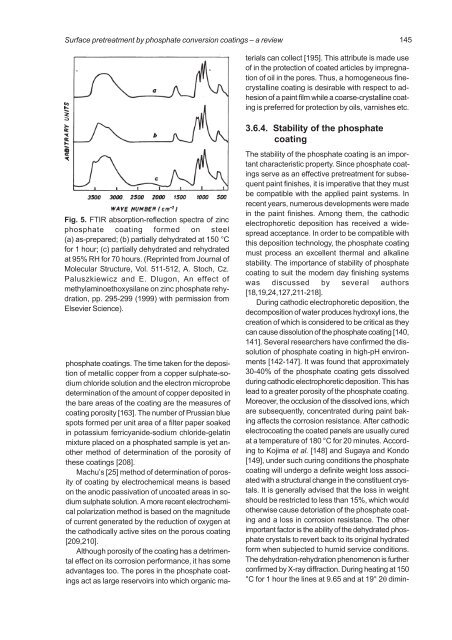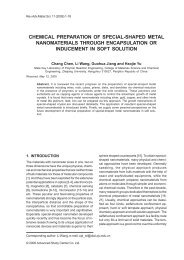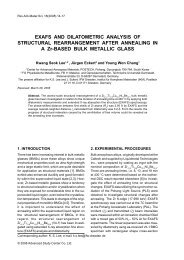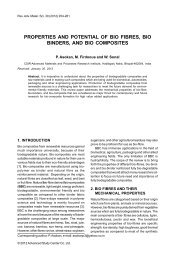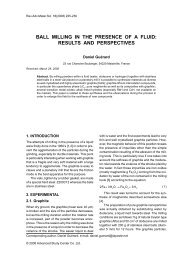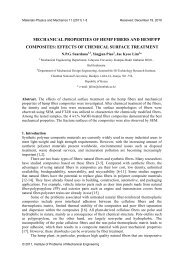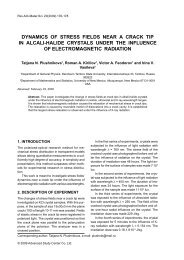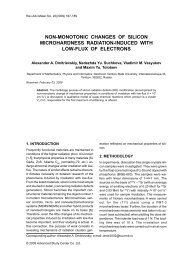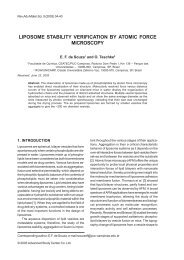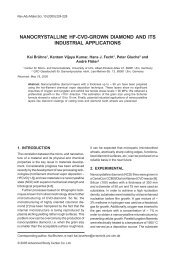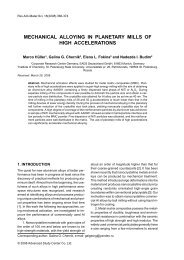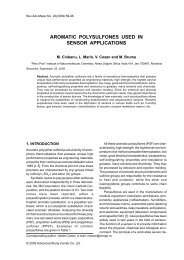surface pretreatment by phosphate conversion coatings – a review
surface pretreatment by phosphate conversion coatings – a review
surface pretreatment by phosphate conversion coatings – a review
You also want an ePaper? Increase the reach of your titles
YUMPU automatically turns print PDFs into web optimized ePapers that Google loves.
Surface <strong>pretreatment</strong> <strong>by</strong> <strong>phosphate</strong> <strong>conversion</strong> <strong>coatings</strong> <strong>–</strong> a <strong>review</strong><br />
Fig. 5. FTIR absorption-reflection spectra of zinc<br />
<strong>phosphate</strong> coating formed on steel<br />
(a) as-prepared; (b) partially dehydrated at 150 °C<br />
for 1 hour; (c) partially dehydrated and rehydrated<br />
at 95% RH for 70 hours. (Reprinted from Journal of<br />
Molecular Structure, Vol. 511-512, A. Stoch, Cz.<br />
Paluszkiewicz and E. Dlugon, An effect of<br />
methylaminoethoxysilane on zinc <strong>phosphate</strong> rehydration,<br />
pp. 295-299 (1999) with permission from<br />
Elsevier Science).<br />
<strong>phosphate</strong> <strong>coatings</strong>. The time taken for the deposition<br />
of metallic copper from a copper sulphate-sodium<br />
chloride solution and the electron microprobe<br />
determination of the amount of copper deposited in<br />
the bare areas of the coating are the measures of<br />
coating porosity [163]. The number of Prussian blue<br />
spots formed per unit area of a filter paper soaked<br />
in potassium ferricyanide-sodium chloride-gelatin<br />
mixture placed on a <strong>phosphate</strong>d sample is yet another<br />
method of determination of the porosity of<br />
these <strong>coatings</strong> [208].<br />
Machu’s [25] method of determination of porosity<br />
of coating <strong>by</strong> electrochemical means is based<br />
on the anodic passivation of uncoated areas in sodium<br />
sulphate solution. A more recent electrochemical<br />
polarization method is based on the magnitude<br />
of current generated <strong>by</strong> the reduction of oxygen at<br />
the cathodically active sites on the porous coating<br />
[209,210].<br />
Although porosity of the coating has a detrimental<br />
effect on its corrosion performance, it has some<br />
advantages too. The pores in the <strong>phosphate</strong> <strong>coatings</strong><br />
act as large reservoirs into which organic ma-<br />
145<br />
terials can collect [195]. This attribute is made use<br />
of in the protection of coated articles <strong>by</strong> impregnation<br />
of oil in the pores. Thus, a homogeneous finecrystalline<br />
coating is desirable with respect to adhesion<br />
of a paint film while a coarse-crystalline coating<br />
is preferred for protection <strong>by</strong> oils, varnishes etc.<br />
3.6.4. Stability of the <strong>phosphate</strong><br />
coating<br />
The stability of the <strong>phosphate</strong> coating is an important<br />
characteristic property. Since <strong>phosphate</strong> <strong>coatings</strong><br />
serve as an effective <strong>pretreatment</strong> for subsequent<br />
paint finishes, it is imperative that they must<br />
be compatible with the applied paint systems. In<br />
recent years, numerous developments were made<br />
in the paint finishes. Among them, the cathodic<br />
electrophoretic deposition has received a widespread<br />
acceptance. In order to be compatible with<br />
this deposition technology, the <strong>phosphate</strong> coating<br />
must process an excellent thermal and alkaline<br />
stability. The importance of stability of <strong>phosphate</strong><br />
coating to suit the modern day finishing systems<br />
was discussed <strong>by</strong> several authors<br />
[18,19,24,127,211-218].<br />
During cathodic electrophoretic deposition, the<br />
decomposition of water produces hydroxyl ions, the<br />
creation of which is considered to be critical as they<br />
can cause dissolution of the <strong>phosphate</strong> coating [140,<br />
141]. Several researchers have confirmed the dissolution<br />
of <strong>phosphate</strong> coating in high-pH environments<br />
[142-147]. It was found that approximately<br />
30-40% of the <strong>phosphate</strong> coating gets dissolved<br />
during cathodic electrophoretic deposition. This has<br />
lead to a greater porosity of the <strong>phosphate</strong> coating.<br />
Moreover, the occlusion of the dissolved ions, which<br />
are subsequently, concentrated during paint baking<br />
affects the corrosion resistance. After cathodic<br />
electrocoating the coated panels are usually cured<br />
at a temperature of 180 °C for 20 minutes. According<br />
to Kojima et al. [148] and Sugaya and Kondo<br />
[149], under such curing conditions the <strong>phosphate</strong><br />
coating will undergo a definite weight loss associated<br />
with a structural change in the constituent crystals.<br />
It is generally advised that the loss in weight<br />
should be restricted to less than 15%, which would<br />
otherwise cause detoriation of the <strong>phosphate</strong> coating<br />
and a loss in corrosion resistance. The other<br />
important factor is the ability of the dehydrated <strong>phosphate</strong><br />
crystals to revert back to its original hydrated<br />
form when subjected to humid service conditions.<br />
The dehydration-rehydration phenomenon is further<br />
confirmed <strong>by</strong> X-ray diffraction. During heating at 150<br />
°C for 1 hour the lines at 9.65 and at 19° 2θ dimin-


